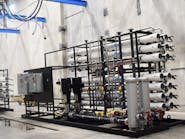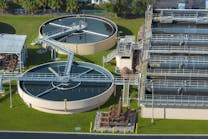Q
What is the most important waterborne disease risk in the U.S.? — U.S.
A
It is legionellosis and it can be fatal! Distribution and plumbing system deficiencies are the most significant sources of waterborne disease in the U.S. and probably in all developed countries. In the past, source water contamination and inadequate water treatment or treatment breakdowns were the major sources of traditional waterborne diseases. Since the passage in 1974 and implementation of the Safe Drinking Water Act after about 1978, however, new EPA regulations were implemented. Public water systems have undertaken major improvements in installations and operations of treatment technologies and water quality monitoring, and the traditional waterborne diseases have been reduced significantly. However, the types of illnesses have changed to water distribution-related causes that can’t be entirely eliminated at the central municipal water treatment plant. This calls for a radically different approach to protect public health by regulators and the public.
Waterborne disease surveillance data
The Centers for Disease Control and Prevention (CDC) keeps track of and periodically reports on the incidence of waterborne disease and cases in the Morbidity and Mortality Weekly Report (MMWR). There were 851 reported outbreaks from 1971 to 2010. The biennial reports have ranged from lows of about five incidences to a high of 48 in 1980-81. The incidence trends have been generally downward from 1980. The types of reported waterborne illnesses have included viral, bacterial, parasitic and chemical. In the early reports most of the etiologic agents causing the diseases were not identifiable, but as the microbiological and surveillance responses have improved, now almost all specific causes are identified. It was assumed that many of the unidentifiable outbreaks were due to viruses, because viruses could not be efficiently isolated and identified. However, with better disinfection viruses are now a small component.
In the CDC MMWR for 2009-2010, waterborne disease outbreaks totaled 33 and they resulted in 1,040 cases and 85 hospitalizations and eight deaths. In all but one outbreak the etiologic causes were identified. Campylobacter accounted for 12 percent of the outbreaks and 78 percent of the illnesses. Four outbreaks were caused by Giardia, one by cryptosporidium, two by E. coli, one norovirus, one hepatitis A and one was undetermined. The shocker is that 19 of the 33 outbreaks were caused by legionella, resulting in 72 cases and all eight deaths. Six more legionellosis deaths were associated with other drinking water originated exposures such as from fountains or cooling systems, and it was the only waterborne illness that resulted in deaths.
Legionellosis has been a reportable disease only since 2001. The disease is not caused by ingestion of the water, but rather by inhalation of aerosols such as during showering or from inhaling blow down from cooling system heat exchangers, or probably even humidifiers. Those at particular risk are the elderly and especially people with impaired immune systems such as those who are hospitalized and in extended care facilities, but they are everywhere in the community. It is well known that legionella are detectable in a high percentage of plumbing systems, including in homes, hotels and other buildings, and a substantial number of people in the general population are susceptible because of their ages or health or immune status. Several hospital-related outbreaks of legionella related diseases are reported annually around the world, but undoubtedly most are not identified or attributed to the water system. CDC has estimated that between 8,000 and 18,000 people are hospitalized with Legionnaires'-related disease each year in the U.S. It is not known how many of those are attributable to exposure from the plumbing or cooling systems.
Legionella and plumbing systems
Legionella microorganisms are common environmental and soil bacteria. Water treatment at the central plant is capable of removing them from influent water, however, if even a few enter distribution/plumbing systems, through the plant or during main breaks or from being present on pipe interior surfaces at installation, the water distribution environment is conducive to colonization. They can proliferate at temperatures in the range of about 25oC to 55oC (77oF to 130oF) such as can be found in hot water systems, shower heads and in cold water systems in warm climates, or during warm times of the year. Yet many “authorities” advise homeowners and building managers to maintain hot water temperatures below 120oF for energy efficiency and to reduce water heating costs. That is an ideal condition for legionella proliferation.
Other risks from distributed water
Numerous pathogenic regrowth microorganisms are known to colonize water distribution and plumbing systems and nosocomial infections have been attributable to exposures from water. In addition to Legionella pneumophila, Pseudomonas aruginosa, Stenotrophomonas maltophilia, Acenotobacter baumannii and Mycobacterium avium are among waterborne opportunistic pathogens found in treated water and linked to nosocomial infections in susceptible persons.
Treatment technologies for managing Legionella and other regrowth microorganisms
Treatment is a real challenge and a cookie cutter approach is not likely to be widely successful. The problem of controlling microorganisms colonizing plumbing and distribution systems is not trivial because many of them are associated with biofilms or protozoa such as amoebas. Thus, even though they may be susceptible to disinfection in suspension, the disinfectants may not have ready access to them in biofilms so that they can be killed. Disinfectants that have been employed have had limited success. They include chlorine, chloramine, chlorine dioxide, ozone, UV light, copper/silver ionization and shock thermal and steam treatments. Each of them has its benefits and weaknesses, and often a combination of treatments must be applied on a regular basis supported by monitoring to indicate the conditions of the system and the time to re-treat. Chlorine is a powerful disinfectant, but even when applied in a temporary hyperchlorination mode (e.g., 50 ppm for several hours) total eradication may not be achieved. Chloramines, which are far less potent than free chlorine, have demonstrated considerable success in reducing legionella counts in some water plumbing systems. This could be due to the lower chemical reactivity of chloramine and greater hydrophobicity that allows greater penetration into biofilms. Chlorine dioxide is a potent disinfectant that also has had mixed success. On-site generation and survival of a residual in far plumbing reaches and in hot water systems can be a problem. Ozone and UV might have some efficacy in recirculating systems, but they will be primarily effective against organisms in the water column. Copper/silver in combination and individually have shown successes when they are properly managed and maintained. Shock thermal treatment for several hours at temperatures above 70oC have shown temporary success, but a complete strategy would require a combination of initial biofilm cleanout with a disinfectant system that will retard regeneration of the biofilm.
The concept of final barrier protection has value in situations where sufficient risk exists. For example, instant hot water delivery systems leave a smaller volume of water to stagnate and provide a growth environment. Temperature control valves at faucets and showerheads allow maintaining hot water lines at temperatures above the oC upper legionella growth temperature, and then blending with cold water at the point-of-use to prevent scalding risk.
Regulatory impediments
If a building such as a hospital wishes to install treatment to manage legionella and other regrowth bacteria, the current interpretations of drinking water regulations actually makes it more difficult for them to do so. The EPA drinking water regulations require that if any facility that has more than 25 users adds treatment to the public water entering the facility, it becomes a public water supply and then becomes subject to a variety of monitoring, management and reporting requirements with the associated costs. A hospital would become a Non Transient Non Community Water Supply (NTNCWS), because it does not have permanent residents. The NTNCWS designation is certainly a disincentive for a facility to install treatment that could save lives. The rationale for the NTNCWS designation is that if the water supply is modified by a user, there is the possibility that contamination could occur and also that drinking water standards could be exceeded. That is technically true, however, not fully reasonable for a case such as a hospital. If, for example, chlorine was being added, the chlorine MRDL, and THM or HAA disinfection byproduct standards might be exceeded, but they are not significant risks. However, additional microbial MCL monitoring is not justified, because the supplemental disinfection treatment is intended to reduce microbial contamination. So, it should be possible to devise a special category exemption for hospital facilities, or utilize a separate oversight process, such as part of the normal accreditation requirements to which health care facilities are subjected. Hot water is not really regulated as drinking water so it should be exempted.
Conclusion
Pathogenic microorganisms such as legionella frequently colonize water plumbing systems, and they now are the most significant public health risk associated with drinking water. Many illnesses and deaths are attributable to that problem and drinking water standards are not designed to deal with them. Indeed, the existing standards may actually result in increased public health risks because they provide a disincentive for health care facilities to take corrective actions. The risk benefit balance is clearly in favor of eliminating the burdens that are imposed upon those facilities, so that they will be more likely to take actions to reduce risks to their patients.
Dr. Cotruvo is president of Joseph Cotruvo and Associates, LLC, Water, Environment and Public Health Consultants. He is a former director of the U.S. EPA Drinking Water Standards Division


